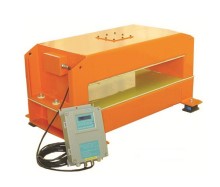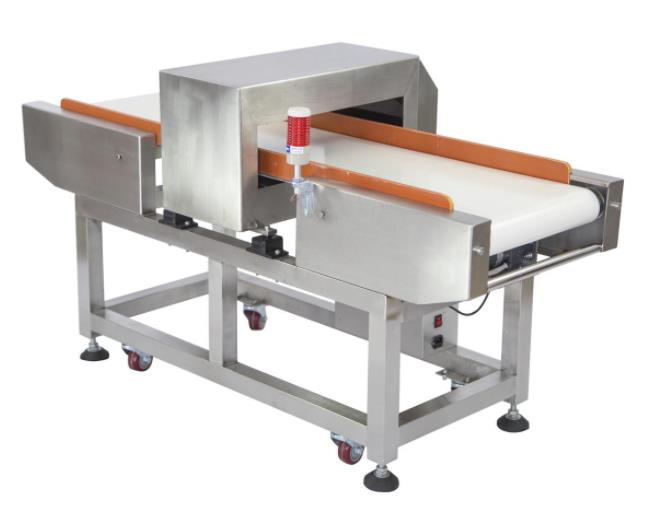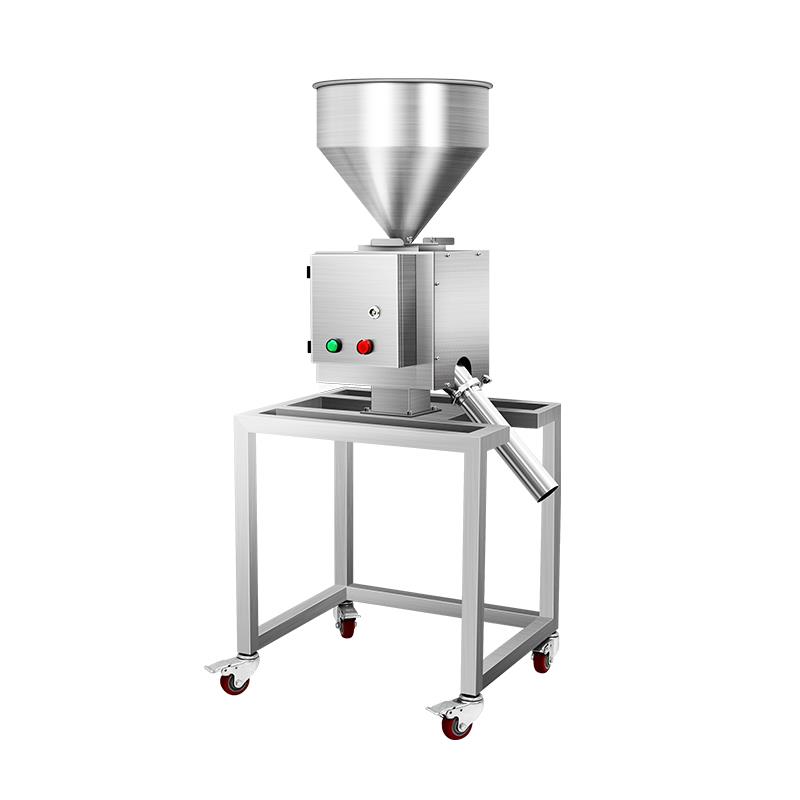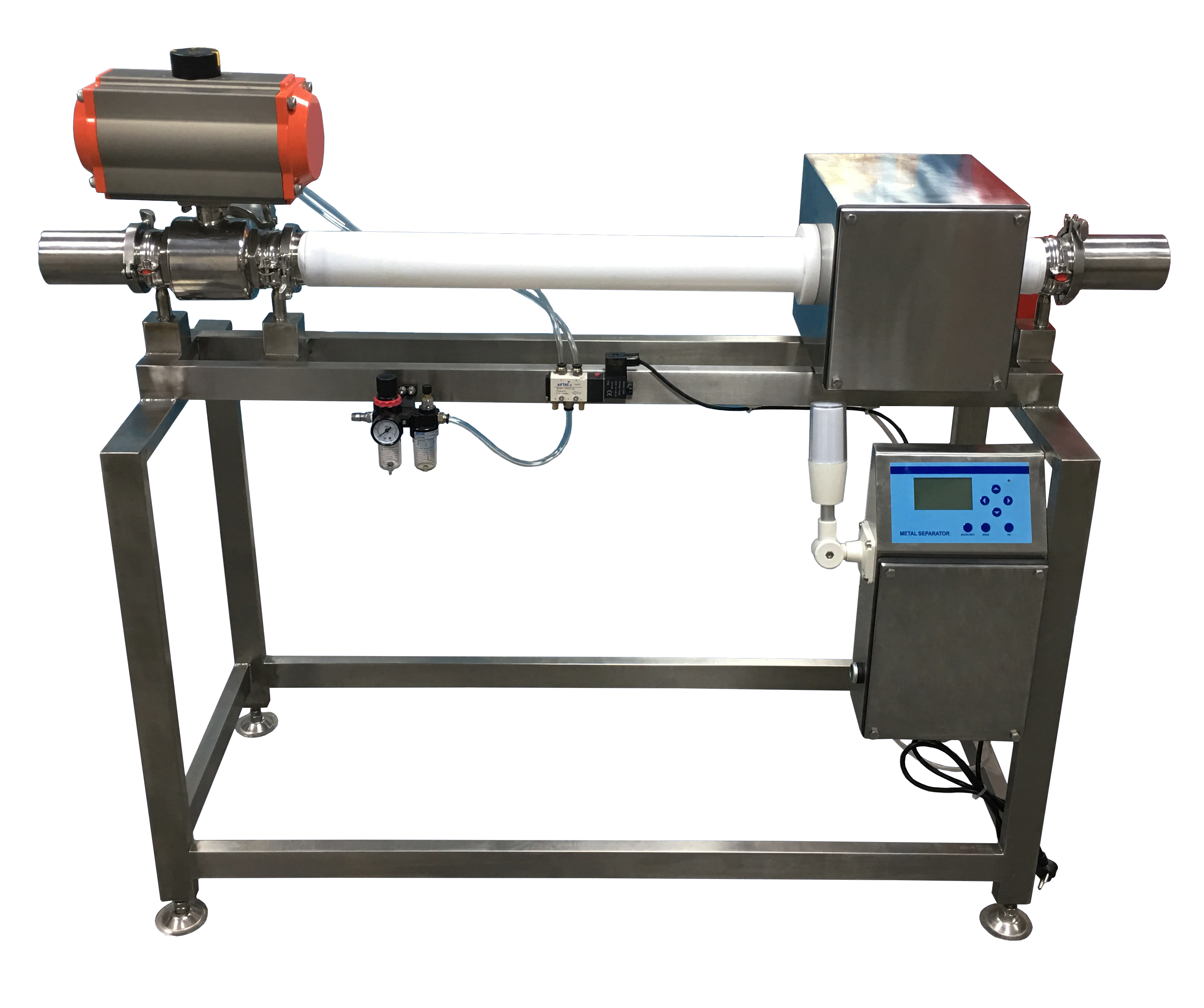How many kinds of industrial metal detectors?
The industrial metal detector is a metal detection device, which is composed of a metal detector and an automatic rejection device(in option), in which the detector is the core part. The system can use the alarm signal to drive an automatic rejection device, etc., so as to exclude metal impurities from the production line.
There are three sets of coils distributed inside the detector, namely the central transmitting coil and two equivalent receiving coils. The oscillator connected to the transmitting coil in the middle generates a high-frequency variable magnetic field. In the idle state, the induced voltage of the receiving coils on both sides Before the magnetic fields are disturbed, they cancel each other out and reach an equilibrium state.
Once the metal impurities enter the magnetic field and the magnetic field is disturbed, this balance is broken, and the induced voltages of the two receiving coils cannot be cancelled. The un-cancelled induced voltages are amplified and processed by the control system, and an alarm signal is generated (metal impurities are detected ). The system can use the alarm signal to drive an automatic rejection device, etc., so as to exclude metal impurities from the production line.
The
components used in metal detectors have been updated and developed from
electron tubes, transistors and even integrated circuits, and their
applications have been expanded to almost all fields, which play an important
role in industrial production and personal safety.
Divided by the way the detected items are transported, metal detectors are usually divided into: channel type, falling type and pipeline type.
1. Split channel type:

Need to adjust the split type after splitting:
The split metal detector mainly adopts the upper and lower parts which can be separated, which is convenient for customers to install and use. However, there is a problem that the sensor needs to be assembled again after separation, and the sensitivity of the device needs to be adjusted after the conventional split body is assembled again.
There is no need to adjust the split type after splitting: For the convenience of customers, the designed split type sensor can be free of debugging. This type of sensor has good easy-to-use and maintenance-free characteristics.
2. Integrated channel conveyor metal detector:

The most common metal detection equipment on the market is a channel-type conveyor metal detector. The channel of the detector is square, usually equipped with a conveyor belt mechanism, with an automatic rejection device, or providing an alarm signal. When the items on the conveyor belt pass through the detector, once there is metal, it will automatically be rejected or stop conveying. Mainly for on-line inspection of finished and semi-finished products, providing final inspection before shipment.
For
example: bagged materials, boxed products, etc.

Falling metal detectors generally have automatic rejection devices, so they are used to call them falling metal detectors or metal detectors.
The packaging requirements of the metal detector for the product are not to contain metal, but considering the higher requirements of tightness, light-proofing, etc., it must be packaged with a metal composite film. The metal composite film itself is metal, so if a channel-type metal detector is used, the detection sensitivity will have a large deviation, and it may even be impossible to detect. In view of the above reasons, you can choose to test before packaging.
The
falling body metal detector was developed in response to the above situation,
and is mainly used for the detection of tablets, capsules and granular (plastic
particles, etc.) and powdery items. When these items fall through the falling
metal detector, once metal impurities are detected, the system immediately
activates the separation mechanism to eliminate suspicious items. It has the
characteristics of simple installation, high sensitivity, convenient
maintenance, high efficiency, stability and reliability.

General metal detectors cannot completely monitor the entire production process of fluid products, such as ham meat sauce, chewing gum, oral liquid, etc., and remove metal impurities online in real time to ensure that the product is safely transported to the next process. Under normal circumstances, these products are encapsulated in metal, and generally cannot be detected with a metal detector after becoming a finished product. In addition, the detection of liquid or viscous items before canning or packaging can effectively improve the detection accuracy.
Whether it is the food, medicine, and rubber industries, or the textile, paper, ore and recycling industries, we can provide metal detectors or separators that meet their requirements.
The accuracy and reliability of the metal detector depend on the frequency stability of the electromagnetic transmitter, and the operating frequency from 80 to 800 kHz is generally used. The lower the working frequency, the better the detection performance of iron; the higher the working frequency, the better the detection performance of high carbon steel. The sensitivity of the detector decreases as the detection range increases, and the size of the inductive signal depends on the size of the metal particles and the conductivity.
Due to the current pulsation and current filtering, the metal detector has certain limitations on the conveying speed of the detected items. If the conveying speed exceeds a reasonable range, the sensitivity of the detector will decrease.
In order to ensure that the sensitivity does not decrease, a suitable metal detector must be selected to suit the corresponding product being tested.
Generally, the detection range should be kept as small as possible. For products with good high-frequency inductance, the size of the detector channel should match the product size. The adjustment of the detection sensitivity should be determined with reference to the center of the detection coil, and the center position has the lowest induction. The detection value of the product will change with the change of production conditions, such as changes in temperature, product size, humidity, etc., which can be adjusted and compensated through the control function
Spherical objects are repetitive, have the smallest surface area, and are the most difficult to detect for metal detectors. Therefore, the ball can be used as a reference sample for detection sensitivity. For non-spherical metals, the detection sensitivity largely depends on the location of the metal. Different locations have different cross-sectional areas, and the detection effect is also different. For example, when passing longitudinally, iron is more sensitive; while high carbon steel and non-iron are less sensitive. When passing horizontally, iron is less sensitive, while high-carbon steel and non-iron are more sensitive.
In the food industry, systems usually use higher operating frequencies. For food such as cheese, due to its inherent high-frequency induction performance, it will proportionally increase the response of high-frequency signals. Moist fat or salt substances, such as bread, cheese, sausages, etc., have the same conductivity as metals. In this case, in order to prevent the system from giving false signals, the compensation signal must be adjusted to reduce the sensitivity of the induction.
The functions of the metal detector are divided into:
1) All metal detector: can detect all metals such as iron, stainless steel, copper, aluminum. The detection accuracy and sensitivity are relatively high, stable, and reliable.
2) Iron metal detector: it can only detect iron metal, commonly known as needle detector. The detection accuracy and sensitivity are low and it is easy to interfere with.
3) Aluminum foil metal detector: It can only detect ferrous metals, but when detecting products with aluminum foil packaging, its detection accuracy and sensitivity are still high.
The effect of the product on the performance of the metal detector:
The detected non-metallic materials generally have a certain product effect, and the size of the product effect directly affects the working performance of the metal detector. The digital metal detector uses the ability of digital signal processing to compensate the product effect to a certain extent, which can reduce the influence of the product effect on the metal detector in the working process. The detection performance of the metal detector can be increased.
General manufacturers often solve this problem from three aspects.
1. Using the knowledge of the characteristics of product effects, using intelligent recognition to distinguish the difference between metal and product effects, and improve the working performance of the metal detector; generally good detection performance can be achieved, but the detection of aluminum foil packaging products requires special custom made.
2. Use different product effects to improve the performance of the detector in response to the different operating frequencies of the detector, but the problem is that this method will reduce the sensitivity to non-ferromagnetic metals, and often increase the performance of ferromagnetic metals. Performance has reduced the sensitivity of stainless steel.
3.
Use two or more frequencies to work and use a metal detector with feature
analysis; this method is considered a compromise technology, which can achieve
a certain effect, and the general working condition will improve the detection
of some ferromagnetic metals Sensitivity, but the performance improvement for
stainless steel is limited.
Securina is a professional manufacturer of industrial metal detector and security metal detectors from China. Our smart training mode of SA810 food metal detector, how to set the sensitivity in fast way. Check link in youtube: https://youtu.be/mqC4HtBu9w4